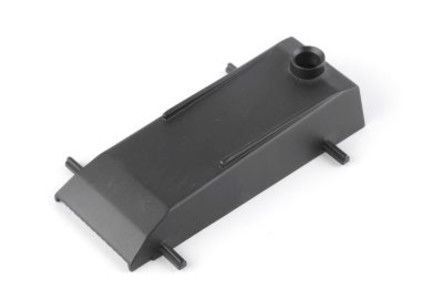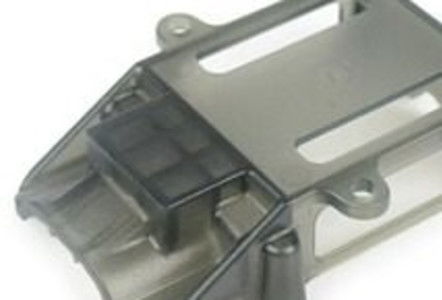Injection Molding
Our injection molding capabilities
| Name | Description |
| Single cavity molds | Molds containing only one cavity, producing one unit per run. |
| Molds with side-action cores | Cores slide out of the part from the side before it is ejected from the mold. This allows for undercuts to be molded. |
| Multi-cavity molds | Multiple identical cavities are machined into the mold tool. This allows for more parts to be produced per shot, minimizing the unit costs. |
| Family Molds | Several parts are designed into the same mold tool. This allows for the minimization of tooling costs. |
| Insert molding | Inserts are placed into the mold and molding occurs around them. This allows for inserts such as helicoils to be molded in your design. |
| Overmolding | Premade parts are placed into the mold to mold over them. This allows for multi-material injection molding |
Our injection molding service
Our injection molding service allows you to seeminglessly move from prototyping to end-part production.
| Name | Description |
| Mold material | Tool Steel P20, Carbon Steel S50C |
| Mold storage | Minimum 2 years |
| Mold lead time | Typically 4-5 weeks |
| Quality assurance | Inspection reports included, full dimensional report and material certifications available upon request. |
| Design verification program | Similar to First Article Inspection, you will receive 2 sets of parts upon the machining of the mold to test fit before continuing with full production. |
| Mold remachining | We can remachine the molds should any changes be required, changes to be reviewed on a case by case basis. |
| Additional technical support | Dedicated Mechanical Specialists for technical support. |
Available materials for injection molding
All thermoplastics can be injection molded. Some thermosets and liquid silicones are also compatible with the injection molding process.
Additives and fibers
Tuff Cor offers additives and reinforcements as options for your plastics parts.
| Name | Description | |
| UV absorbers | Absorb UV radiation, slowing down the degradation of the material when used outdoors | |
| Flame retardants | Prevent ignition and inhibits spread of fire. | |
| Increase flexibility and promotes plasticity, reducing brittleness of the material. | |
| Colorants | Used to color plastics. | |
| Carbon fibers | Increase strength, toughness, and rigidity of the material at the expense of making the material more brittle. | |
| Glass fibers | Increase strength, toughness, and rigidity of the material at the expense of making the material more brittle. It is more flexible than carbon fibers. |
Injection molded parts are not usually post-processed, but the mold itself can be finished to affect the surface finish of the molded part.
This way aesthetic needs or technical requirements can be achieved.
Glossy

SPI Standard - A-1, A-2, A-3
Description - The mold is smoothed and then polished with a diamond buff, resulting in parts with a mirror-like finish.
Semi-gloss
SPI Standard - B-1, B-2, B-3
Description - The mold is smoothed with fine grit sandpaper, resulting in parts with a fine surface finish.
Matte
 SPI Standard - C-1, C-2, C-3
SPI Standard - C-1, C-2, C-3
Description - The mold is smoothed using fine stone powder, removing all machining marks.
Textured finish
SPI Standard - D-1, D-2, D-3
Description - The mold is first smoothed with fine stone powder and then sandblasted, resulting in a textured surface.

As-machined finish
Description - The mold is finished to the machinist's discretion. Tool marks may be visible.
Injection molding design guidelines
The table below summarizes the recommended and technically feasible values for the most common features encountered in injection molding.
| Feature | Recommended | Description |
| Wall Thickness | Thickness: 1 mm and 3 mm | To avoid warping and sinking, parts should be designed with the smallest possible and constant wall thickness. |
| Smooth transitions | 3 × wall thickness difference | If wall thickness cannot be avoided, use a chamfer or fillet to make the transition as smooth as possible. |
| Rounded edges | Internal edges: > 0.5 × wall thickness External edges: internal fillet + wall thickness | Add a fillet with a radius that is as large as possible to all internal and external edges. |
| Draft angle | For parts taller than 50 mm: increase the draft by 1° for every 25 mm For parts with a textured finish: increase the draft by an extra 1°-2° | Add a draft to all vertical walls to make the ejection of the part easier and avoid drag marks. |
Upload files and configure parts to get a quote
Disclaimer
Tuff Cor will be able to help you with all your manufacturing and product development need through our in-house services and knowledge. We make use of our large network of reliable supplier for any service we do not have in-house.
F.A.Q
How does injection molding work
- Injection molding is a manufacturing process in the production of parts from thermoplastic and thermoset plastics. Molten plastic is inserted into the cavity of the mold, where it cools and solidifies to the shape of the hole. After the part is removed from the mold, it may undergo further processing, such as trimming, machining, or decorating.
Is injection molding cost effective
How many types of injection molding are there
Contact
- 57 Genl Van Reyneveld Street, Persequor, Pretoria, South Africa
